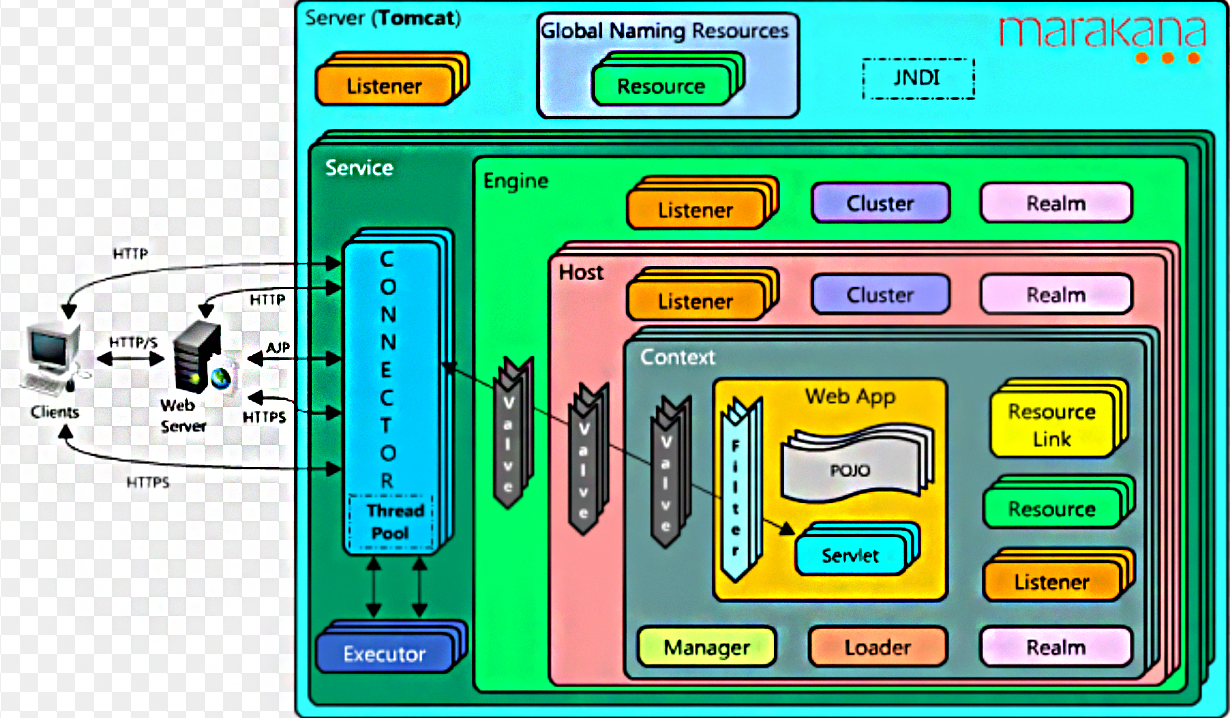Tomcat的架构图


图三:Tomcat Server处理一个HTTP请求的过程
处理HTTP请求过程
假设来自客户的请求为:http://localhost:8080/test/index.jsp 请求被发送到本机端口8080
1、用户点击网页内容,请求被发送到本机端口8080,被在那里监听的Coyote HTTP/1.1 Connector获得。
2、Connector把该请求交给它所在的Service的Engine来处理,并等待Engine的回应。
3、Engine获得请求localhost/test/index.jsp,匹配所有的虚拟主机Host。
4、Engine匹配到名为localhost的Host(即使匹配不到也把请求交给该Host处理,因为该Host被定义为该Engine的默认主机),名为localhost的Host获得请求/test/index.jsp,匹配它所拥有的所有的Context。Host匹配到路径为/test的Context(如果匹配不到就把该请求交给路径名为“ ”的Context去处理)。
5、path=“/test”的Context获得请求/index.jsp,在它的mapping table中寻找出对应的Servlet。Context匹配到URL PATTERN为*.jsp的Servlet,对应于JspServlet类。
6、构造HttpServletRequest对象和HttpServletResponse对象,作为参数调用JspServlet的doGet()或doPost().执行业务逻辑、数据存储等程序。
7、Context把执行完之后的HttpServletResponse对象返回给Host。
8、Host把HttpServletResponse对象返回给Engine。
9、Engine把HttpServletResponse对象返回Connector。
10、Connector把HttpServletResponse对象返回给客户Browser。
简单模拟Tomcat
tomcat是通过socket和浏览器获得连接,因为可能有多个请求,所以要用到多线程去接收,通过io流来传递数据。
package Server; import java.io.*; import java.net.ServerSocket; import java.net.Socket; import java.net.URLDecoder; import java.util.StringTokenizer; public class TomcatServer { private final static int PORT = 8080; public static void main(String[] args) { try { ServerSocket server = new ServerSocket(PORT);// 根据端口号启动一个serverSocket ServletHandler servletHandler = new ServletHandler(server); servletHandler.start(); } catch (Exception e) { e.printStackTrace(); } } private static class ServletHandler extends Thread { ServerSocket server = null; public ServletHandler(ServerSocket server) { this.server = server; } @Override public void run() { while (true) { try { Socket client = null; client = server.accept();// ServerSocket阻塞等待客户端请求数据 if (client != null) { try { System.out.println("接收到一个客户端的请求"); // 根据客户端的Socket对象获取输入流对象。 // 封装字节流到字符流 BufferedReader reader = new BufferedReader(new InputStreamReader(client.getInputStream())); // GET /test.jpg /HTTP1.1 // http请求由三部分组成,分别是:请求行、消息报头、请求正文。 // 这里取的第一行数据就是请求行。http协议详解可以参考http://www.cnblogs.com/li0803/archive/2008/11/03/1324746.html说的很详细 String line = reader.readLine(); System.out.println("line: " + line); // 拆分http请求路径,取http需要请求的资源完整路径 String resource = line.substring(line.indexOf('/'), line.lastIndexOf('/') - 5); System.out.println("the resource you request is: " + resource); resource = URLDecoder.decode(resource, "UTF-8"); // 获取到这次请求的方法类型,比如get或post请求 String method = new StringTokenizer(line).nextElement().toString(); System.out.println("the request method you send is: " + method); // 继续循环读取浏览器客户端发出的一行一行的数据 while ((line = reader.readLine()) != null) { if (line.equals("")) {// 当line等于空行的时候标志Header消息结束 break; } System.out.println("the Http Header is : " + line); } // 如果是POST的请求,直接打印POST提交上来的数据 if ("post".equals(method.toLowerCase())) { System.out.println("the post request body is: " + reader.readLine()); } else if ("get".equals(method.toLowerCase())) { // 判断是get类型的http请求处理 // 根据http请求的资源后缀名来确定返回数据 // 比如下载一个图片文件,我这里直接给定一个图片路径来模拟下载的情况 if (resource.endsWith(".jpg")) { transferFileHandle("d://1.jpg", client); closeSocket(client); continue; } else { // 直接返回一个网页数据 // 其实就是将html的代码以字节流的形式写到IO中反馈给客户端浏览器。 // 浏览器会根据http报文“Content-Type”来知道反馈给浏览器的数据是什么格式的,并进行什么样的处理 PrintStream writer = new PrintStream(client.getOutputStream(), true); writer.println("HTTP/1.0 200 OK");// 返回应答消息,并结束应答 writer.println("Content-Type:text/html;charset=utf-8"); writer.println(); // writer.println("Content-Length:" + // html.getBytes().length);// 返回内容字节数 writer.println("<html><body>"); writer.println("<a href='www.baidu.com'>百度</a>"); writer.println( "<img src='https://ss0.bdstatic.com/5aV1bjqh_Q23odCf/static/superman/img/logo/bd_logo1_31bdc765.png'></img>"); writer.println("</html></body>"); // writer.println("HTTP/1.0 404 Not // found");// 返回应答消息,并结束应答 writer.println();// 根据 HTTP 协议, 空行将结束头信息 writer.close(); closeSocket(client);// 请求资源处理完毕,关闭socket链接 continue; } } } catch (Exception e) { System.out.println("HTTP服务器错误:" + e.getLocalizedMessage()); } } } catch (Exception e) { e.printStackTrace(); } } } private void closeSocket(Socket socket) { try { socket.close(); } catch (IOException ex) { ex.printStackTrace(); } System.out.println(socket + "离开了HTTP服务器"); } private void transferFileHandle(String path, Socket client) { File fileToSend = new File(path); if (fileToSend.exists() && !fileToSend.isDirectory()) { try { // 根据Socket获取输出流对象,将访问的资源数据写入到输出流中 PrintStream writer = new PrintStream(client.getOutputStream()); writer.println("HTTP/1.0 200 OK");// 返回应答消息,并结束应答 writer.println("Content-Type:application/binary"); writer.println("Content-Length:" + fileToSend.length());// 返回内容字节数 writer.println();// 根据 HTTP 协议, 空行将结束头信息 FileInputStream fis = new FileInputStream(fileToSend); byte[] buf = new byte[fis.available()]; fis.read(buf); writer.write(buf); writer.close(); fis.close(); } catch (IOException e) { e.printStackTrace(); } } } } }